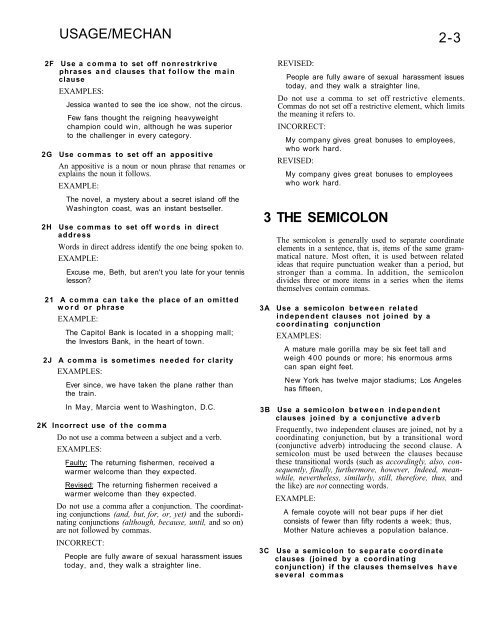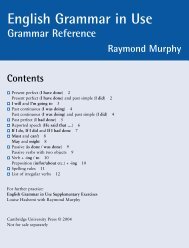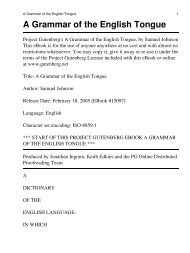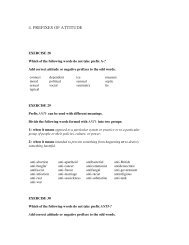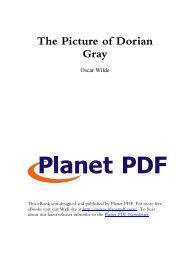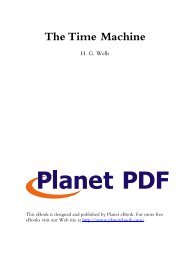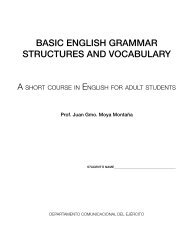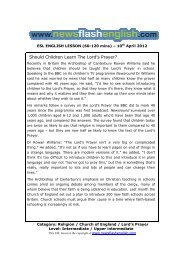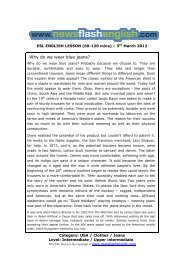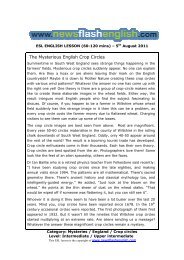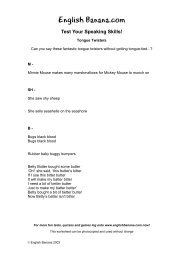TO DOWNLOAD - 75 Pages (928kb - PDF format) - ESL Teachers ...
TO DOWNLOAD - 75 Pages (928kb - PDF format) - ESL Teachers ...
TO DOWNLOAD - 75 Pages (928kb - PDF format) - ESL Teachers ...
Create successful ePaper yourself
Turn your PDF publications into a flip-book with our unique Google optimized e-Paper software.
USAGE/MECHAN 2-32F Use a comma to set off nonrestrkrivephrases and clauses that follow the mainclauseEXAMPLES:Jessica wanted to see the ice show, not the circus.Few fans thought the reigning heavyweightchampion could win, although he was superiorto the challenger in every category.2G Use commas to set off an appositiveAn appositive is a noun or noun phrase that renames orexplains the noun it follows.EXAMPLE:The novel, a mystery about a secret island off theWashington coast, was an instant bestseller.2H Use commas to set off words in directaddressWords in direct address identify the one being spoken to.EXAMPLE:Excuse me, Beth, but aren't you late for your tennislesson?21 A comma can take the place of an omittedword or phraseEXAMPLE:The Capitol Bank is located in a shopping mall;the Investors Bank, in the heart of town.2J A comma is sometimes needed for clarityEXAMPLES:Ever since, we have taken the plane rather thanthe train.In May, Marcia went to Washington, D.C.2K Incorrect use of the commaDo not use a comma between a subject and a verb.EXAMPLES:Faulty: The returning fishermen, received awarmer welcome than they expected.Revised: The returning fishermen received awarmer welcome than they expected.Do not use a comma after a conjunction. The coordinatingconjunctions (and, but, for, or, yet) and the subordinatingconjunctions (although, because, until, and so on)are not followed by commas.INCORRECT:People are fully aware of sexual harassment issuestoday, and, they walk a straighter line.REVISED:People are fully aware of sexual harassment issuestoday, and they walk a straighter line,Do not use a comma to set off restrictive elements.Commas do not set off a restrictive element, which limitsthe meaning it refers to.INCORRECT:My company gives great bonuses to employees,who work hard.REVISED:My company gives great bonuses to employeeswho work hard.3 THE SEMICOLONThe semicolon is generally used to separate coordinateelements in a sentence, that is, items of the same grammaticalnature. Most often, it is used between relatedideas that require punctuation weaker than a period, butstronger than a comma. In addition, the semicolondivides three or more items in a series when the itemsthemselves contain commas.3A Use a semicolon between relatedindependent clauses not joined by acoordinating conjunctionEXAMPLES:3BA mature male gorilla may be six feet tall andweigh 400 pounds or more; his enormous armscan span eight feet.New York has twelve major stadiums; Los Angeleshas fifteen,Use a semicolon between independentclauses joined by a conjunctive adverbFrequently, two independent clauses are joined, not by acoordinating conjunction, but by a transitional word(conjunctive adverb) introducing the second clause. Asemicolon must be used between the clauses becausethese transitional words (such as accordingly, also, consequently,finally, furthermore, however, Indeed, meanwhile,nevertheless, similarly, still, therefore, thus, andthe like) are not connecting words.EXAMPLE:A female coyote will not bear pups if her dietconsists of fewer than fifty rodents a week; thus,Mother Nature achieves a population balance.3C Use a semicolon to separate coordinateclauses (joined by a coordinatingconjunction) if the clauses themselves haveseveral commas


